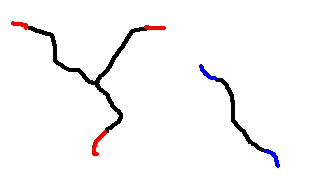Computer Chemistry Consultancy - XML4Pharma, Katzelbachweg 18, A-8052 Thal, Austria, info@CompChemCons.com
Polymer Network calculations using the Miller-Macosko applet
Thermosets are usully formed by a condensation reaction between A-functional monomers and B-functional monomers. If (at least) one of the A-functional monomers has a functionality of at least 3 (i.e. it has 3 reactive A-groups) and (at least) one of the B-functional monomers has a functionality of at least 2, then a polymeric network is formed.

When the network becomes infinite, gelation occurs, and the mechanical
properties sharply improve. This point is named the "gel point". At the gel
point, the weight-average MW becomes infinity, but the number-averaged MW
doesn't.

In the seventies, Miller and Macosko developed a theory to calculate
network properties of gelating thermosets. As the theory is rather
complicated, not many computer programs have been developed that implement
this theory.
From the original publications, we developed a Java applet that
implements the theory. We did this for worlds largest Coatings company.
Before the implementation, this company had only limited access to tools for
predicting whether a thermoset composition will gel or not, and what
properties it will have as function of reaction progress. After the
implementation and deployment on their intranet, suddenly a large amount of
researchers and developers had access to this technology, enabling them to
perform their development work in a much more efficient way.
An analogous tool was developed for the case where a (mixture of) long chain polymer(s) is reacted with a low-molecular weight crosslinker (after the Bauer theory - not shown here).
The Miller-Macosko applet
The applet has a very user-friendly input screen. Using slider and textfields, the functionality, amount, and molecular weight of each of the A- and B-monomers (the picture only shows the part for the A-functional monomers). One click on the "Gel Point" button calculates the gel point within a fraction of a second.A click on the "Pregel" button calculates the properties before gelation, i.e. number- and weight-averaged molecular weight as function of reaction progress. The pregel-results are shown in a graphical way, with a summary and interactive plots (you can zoom in and out in the plots).
When the "Postgel" button is clicked, the properties beyond the gel point are calculated and shown. These include the weight fractions of effecttive chains, pendant and sol as function of reaction progress, as well as the crosslink density and the average molecular weight between the crosslinks. Also a summary of the most important data is given. Also here the plots are fully interactive.